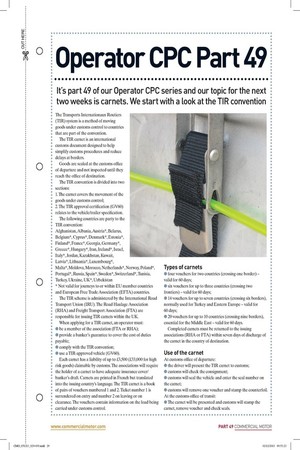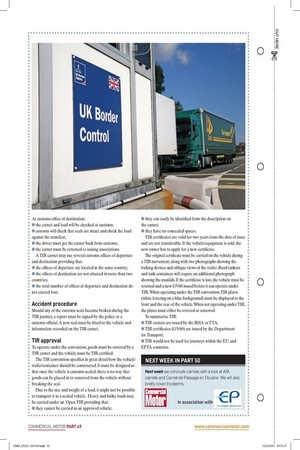Operator CPC Part 49
Page 19

Page 20

If you've noticed an error in this article please click here to report it so we can fix it.
It's part 49 of our Operator CPC series and our topic for the next two weeks is carnets. We start with a look at the TIR convention
The Transports Internationaux Routiers (TIR) system is a method of moving goods under customs control to countries that are part of the convention.
The TIR carnet is an international customs document designed to help simplify customs procedures and reduce delays at borders.
Goods are sealed at the customs office of departure and not inspected until they reach the office of destination. The TIR convention is divided into two sections: 1. The carnet covers the movement of the goods under customs control;
2. The TIR approval certification (GV60) relates to the vehicle/trailer specification. The following countries are party to the TIR convention: Afghanistan, Albania, Austria*, Betarns, Belgium*, Cyprus*, Denmark*, Estonia*, Finland*, France*, Georgia, Germany*, Greece*, Hungary*, Iran, Ireland*, Israel, Italy*, Jordan, Kazakhstan, Kuwait, Latvia*, Lithuania*, Luxembourg*, Malta*, Moldova, Morocco, Netherlands*, Norway, Poland*, Portugal*, Russia, Spain*, Sweden*, Switzerland*, Tunisia, Turkey, Ukraine, UK*, Uzbekistan
* Not valid for journeys to or within EU member countries and European Free Trade Association (EFTA) countries.
The TIR scheme is administered by the International Road Transport Union (IRU). The Road Haulage Association (RHA) and Freight Transport Association (FTA) are responsible for issuing TIR carnets within the UK. When applying for a TIR carnet, an operator must: • be a member of the association (FTA or RHA); • provide a banker's guarantee to cover the cost of duties payable; • comply with the TIR convention;
• use a TIR-approved vehicle (GV60).
Each carnet has a liability of up to £3,500 (£33,000 for high risk goods) claimable by customs. The associations will require the holder of a carnet to have adequate insurance cover/ banker's draft. Carnets are printed in French but translated into the issuing country's language. The TIR carnet is a book of pairs of vouchers numbered 1 and 2. Ticket number 1 is surrendered on entry and number 2 on leaving or on clearance. The vouchers contain information on the load being carried under customs control. Types of carnets • four vouchers for two countries (crossing one border) — valid for 60 days; • six vouchers for up to three countries (crossing two frontiers) — valid for 60 days; • 14 vouchers for up to seven countries (crossing six borders), normally used for Turkey and Eastern Europe — valid for 60 days;
• 20 vouchers for up to 10 countries (crossing nine borders), essential for the Middle East — valid for 60 days.
Completed carnets must be returned to the issuing associations (RHA or FTA) within seven days of discharge of the carnet in the country of destination. Use of the carnet At customs office of departure: • the driver will present the TIR carnet to customs; • customs will check the consignment; • customs will seal the vehicle and enter the seal number on the carnet; • customs will remove one voucher and stamp the counterfoil. At the customs office of transit:
• The carnet will be presented and customs will stamp the carnet, remove voucher and check seals. At customs office of destination: • the carnet and load will be checked at customs; • customs will check that seals are intact and check the load against the manifest; • the driver must get the carnet back from customs; • the carnet must be returned to issuing associations. A TIR carnet may use several customs offices of departure and destination providing that: • the offices of departure are located in the same country; • the offices of destination are not situated in more than two countries;
• the total number of offices of departure and destination do not exceed four. Accident procedure
Should any of the customs seals become broken during the TIR journey, a report must be signed by the police or a customs official. A new seal must be fitted to the vehicle and information recorded on the TIR carnet. TIR approval
To operate under the convention, goods must be covered by a TIR carnet and the vehicle must be TIR certified.
The TIR convention specifies in great detail how the vehicle/ trailer/container should be constructed. It must be designed so that once the vehicle is customs-sealed, there is no way that goods can be placed in or removed from the vehicle without breaking the seal. Due to the size and weight of a load, it might not be possible to transport it in a sealed vehicle. Heavy and bulky loads may be carried under an 'Open TIR providing that: • they cannot be carried in an approved vehicle; • they can easily be identified from the description on the carnet;
• they have no concealed spaces.
TIR certificates are valid for two years from the date of issue and are not transferable. If the vehicle/equipment is sold, the new owner has to apply for a new certificate.
The original certificate must be carried on the vehicle during a TIR movement, along with two photographs showing the locking devices and oblique views of the trailer. Road tankers and tank containers will require an additional photograph showing the manlids. If the certificate is lost, the vehicle must be retested and a new GV60 issued before it can operate under TIR. When operating under the TIR convention, TIR plates (white lettering on a blue background) must be displayed to the front and the rear of the vehicle. When not operating under TIR, the plates must either be covered or removed. To summarise TIR: • TIR carnets are issued by the RHA or FTA; • TIR certificates (GV60) are issued by the Department for Transport;
• TIR would not be used for journeys within the EU and EFTA countries.




































